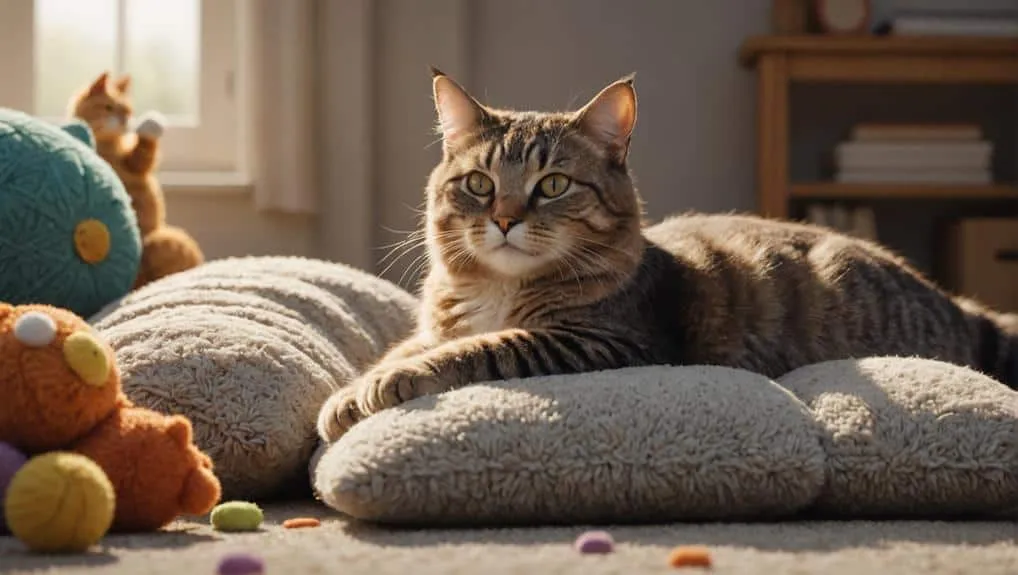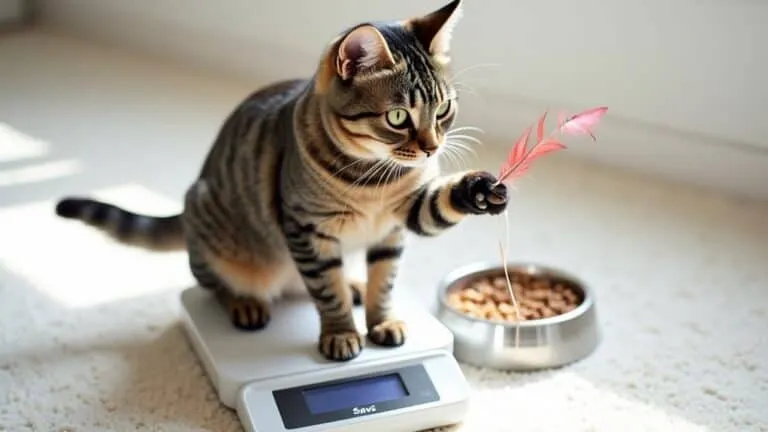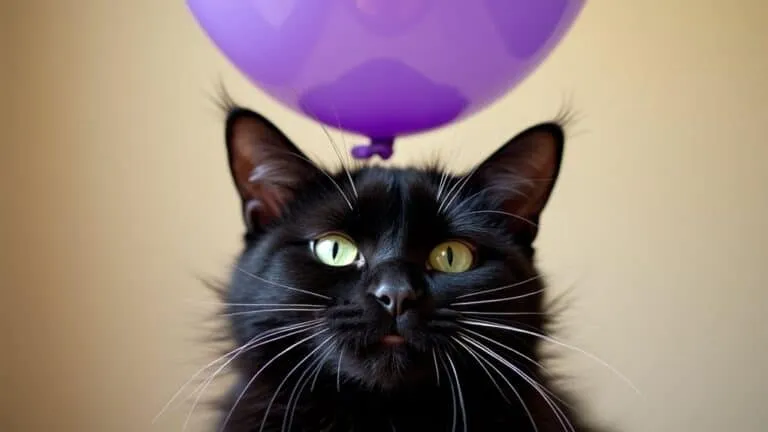The Best Fluffy Pancakes recipe you will fall in love with. Full of tips and tricks to help you make the best pancakes.

So you've figured out that regular cat grooming is key to your cat's comfort and well-being. That's a great start! By grooming your cat regularly, you'll prevent skin problems and discomfort caused by oils and dander, reduce seasonal shedding, and help older cats who struggle to clean themselves.
Regular grooming has loads of benefits. It promotes a healthy coat and skin, prevents matting and shedding, and lets you detect skin issues early on.
The best part is that by learning the right techniques and creating a comfortable environment, you can make grooming a positive experience for your cat. This strengthens your bond and builds trust between you two.
Now, let's dive deeper into refining your approach to give your cat the maximum comfort and care they deserve.
Importance of Regular Grooming
Grooming is a crucial part of your cat's health and happiness. It helps keep their coat, skin, and hygiene in top shape. By doing it every 6-8 weeks, you can keep your cat healthy and happy.
This regular routine helps get rid of natural oils and dander that can cause skin problems and discomfort. It also helps with seasonal shedding, especially during spring and summer, which means fewer hairballs.
As your cat gets older, they might have trouble keeping themselves clean, so these grooming sessions become really important for their comfort and hygiene.
Regular grooming also stops painful matting in the fur, which can be a serious health issue if you don't take care of it.
Grooming for Comfort and Health
Grooming is a crucial part of your cat's routine that goes beyond just looking good. It's essential for their comfort and health.
When you groom your cat regularly, you're not only promoting a healthy coat and skin, but you're also making sure they feel their best. Think about it – if your cat's fur gets all matted and greasy, it can be really uncomfortable for them. By grooming them every 6-8 weeks, you can prevent that from happening.
Daily brushing is also a must. It helps remove loose hair and prevents matting, which can be painful for your cat. Plus, it's a great way to detect any skin issues early on, so you can get them treated before they become a bigger problem.
Now, you might be thinking, 'But won't my cat hate being groomed?' Not if you do it right! Gentle brushing and the occasional bath can actually strengthen the bond between you and your cat. And, if you do it correctly, your cat will feel relaxed and comfortable the whole time.
Enhancing Skin and Coat Health
Grooming plays a huge role in your cat's skin and coat health. By making it a regular part of their routine, you can prevent skin irritations and maintain a lustrous coat. When you groom your cat regularly, you're helping to distribute their natural skin oils. This promotes a healthy, shiny coat and prevents the buildup of grease and dander that can irritate sensitive skin.
Regular grooming has several key benefits for enhancing skin and coat health. For one, it reduces shedding and hairballs. If you brush your cat every few days, you can significantly cut down on the amount of loose hair and hairballs, making life more comfortable and clean for both your cat and your home.
Using the right brushes for your cat's fur type can also prevent matting, which can lead to skin infections or discomfort. Regular grooming sessions also give you a chance to check your cat's skin and catch any potential issues early. This way, you can get them veterinary care before things get serious.
Identifying and Managing Health Issues
As you groom your cat, you're doing more than just making them look good. You're also getting a chance to spot potential health issues before they become serious problems.
When you're grooming, take a close look at your cat's skin. Are they scratching too much? Do they have scabs or bald patches? These could be signs of underlying health issues that need attention.
Also, don't forget to check their ears. Are they dirty or smelly? Are they sensitive when you touch them? These could be signs of infections or ear mites that need to be treated by a vet.
While you're at it, take a look at your cat's teeth and gums. Do they have bad breath or swollen gums? These could be signs of gum disease or other health issues.
Keep an eye out for other symptoms too, like hair loss or skin irritation. These could be signs of allergies to food or things in their environment.
If you notice your cat is grooming excessively or has matted fur, it could be a sign of stress or health problems.
Techniques and Procedures for Grooming
When you're getting ready to groom your cat, it's crucial to learn the basics to make sure it's a safe and enjoyable experience for both you and your pet.
First, let's talk about bathing. You'll want to trim those claws beforehand to avoid any scratching. Then, use a gentle, diluted shampoo to keep things calm.
Regular brushing is also key. It promotes skin health and reduces shedding, which is a win-win for you and your cat.
Bathing Essentials
Want to give your cat a stress-free bathing experience? It's easy! Just follow a few simple steps to ensure a calm and comfortable process for your feline friend.
So, when's the best time to bathe your cat? Try to do it during a calm period, when they're not feeling anxious or energetic. This will help minimize stress.
Also, don't forget to trim their claws beforehand – this is for your safety as much as theirs!
Brushing their fur beforehand is also a good idea, as it removes loose hairs and reduces grease and dead hair accumulation.
And one more thing – use cotton in their ears to prevent water from getting in.
Now, let's talk about the actual bathing process. Use lukewarm water and a handheld spray hose or pitcher to gently wet your cat.
Apply a diluted cat shampoo, but be careful not to get any on their face, ears, or eyes.
After rinsing them thoroughly, use a washcloth dampened with plain water or diluted shampoo to wipe their face clean.
Finally, dry them off with a towel or a low-heat blow dryer to keep them warm and cozy.
Grooming Techniques
Mastering the art of grooming your cat starts with selecting the right tools for the job. You'll want to choose slicker brushes or grooming gloves that are designed to tackle specific coat types and needs.
Regular brushing with these tools has a bunch of benefits. It helps reduce shedding, prevents matting, and maintains a healthy coat. It's also really good for improving blood circulation, which can contribute to your cat's overall well-being.
When you're using grooming gloves, gently massage your cat's skin to stimulate blood flow and relaxation. As you brush, be gentle and patient. If your cat shows signs of stress or discomfort, take a break.
Positive reinforcement with treats can make the experience more pleasant for your cat and strengthen your bond. Remember to create a calm environment, free from distractions, to guarantee a comfortable grooming session.
Grooming for Bonding and Trust
Grooming is a powerful way to bond with your cat and build trust. When you regularly groom your cat, you're tapping into the benefits of mutual grooming, also known as allogrooming. This practice strengthens the bond and trust between you and your cat, improving your overall relationship.
Regular grooming sessions help your cat get used to being handled and touched, which reduces anxiety and makes them feel more secure. So, how can you make the most of grooming time with your cat?
First, establish a consistent routine. If you groom your cat at the same time every day or week, they'll start to feel comfortable and secure. They'll learn that grooming is a safe and enjoyable activity.
Next, use positive reinforcement. Give your cat treats and praise during grooming to make the experience even more enjoyable. This will deepen the bond between you and create a positive association with grooming.
Grooming is also a great opportunity for social interaction, which is essential for your cat's emotional well-being. It's a chance for you to connect with your cat and for them to connect with you.
Creating a Comfortable Grooming Environment
Creating a comfortable space for grooming can really help reduce your cat's stress levels. You can do this by setting up a dedicated area with soft, non-slip mats that provide a safe and comfortable surface for your cat to stand on. This way, your cat will feel more at ease and secure.
Having a regular routine for grooming can also make a big difference. If you groom your cat at the same times every week, they'll get used to the process and it won't be as intimidating. Plus, it'll be more predictable for them.
Good ventilation and a comfortable room temperature are also essential. You don't want your cat to get too hot or uncomfortable during grooming, so make sure the room is at a nice temperature and well-ventilated. This will help keep them relaxed throughout the process.
You can also make grooming a more enjoyable experience by offering treats and positive reinforcement. This will help your cat associate grooming with good things, making them more relaxed and comfortable during sessions.
Frequently Asked Questions
Is Grooming Comforting for Cats?
Grooming is a super comforting activity for cats. When you use gentle techniques, you're actually helping to reduce their stress levels. It's because grooming has a calming effect on felines, making them feel relaxed and promoting their overall well-being.
Do Cats Feel Better After Being Groomed?
Grooming does more than just keep your cat clean – it can actually make them feel better too! The process triggers a state of relaxation in felines, which in turn reduces stress and anxiety. As a result, your cat gets to enjoy the full benefits of grooming, which can significantly improve their overall comfort and well-being.
Do Cats Groom Themselves to Calm Down?
So, you've probably noticed that cats groom themselves a lot, and you might be wondering if they do it to calm down. The answer is yes, they do! When cats groom themselves, it triggers the release of endorphins, which are like natural painkillers that promote relaxation.
Their grooming rituals are actually a way for them to cope with stress, anxiety, and uncertainty. Think about it – when we're feeling stressed or anxious, we might pace back and forth, tap our feet, or engage in some other kind of fidgety behavior. For cats, grooming is their way of releasing tension and calming themselves down.
It's pretty fascinating, if you think about it. Cats have evolved this behavior as a way to deal with the stresses of their environment, and it's something that they do naturally. So, the next time you see your cat licking its fur or scratching its ears, just know that it's not just about keeping clean – it's also about feeling calm and relaxed.
How Do You Groom an Unwilling Cat?
So you've got a cat that's not exactly thrilled about grooming, huh? Well, don't worry, it's not uncommon. The key is to make them feel comfortable and relaxed during the process.
First, you'll want to start with short sessions. Like, really short. We're talking just a few minutes. This will help your cat get used to the idea of being groomed without feeling overwhelmed. As they become more comfortable, you can gradually increase the duration of the sessions.
Positive reinforcement is also crucial. Reward your cat with treats, praise, and affection when they remain calm and relaxed during grooming. This will help them associate the experience with good things.
And remember, gentle grooming techniques are a must. Be gentle, be patient, and move at your cat's pace. If they start to get stressed or anxious, it's okay to stop and try again another time. With time and patience, your unwilling cat can become a grooming pro!
Final Thoughts
By prioritizing regular cat grooming, you've taken a crucial step towards promoting your cat's overall comfort and well-being.
This investment of time and effort will really pay off – you'll have a healthier, happier cat as a result.
Grooming is a significant aspect of cat care, and by following the techniques and procedures outlined above, you'll be able to identify potential health issues early on and foster a deeper bond with your feline friend.








